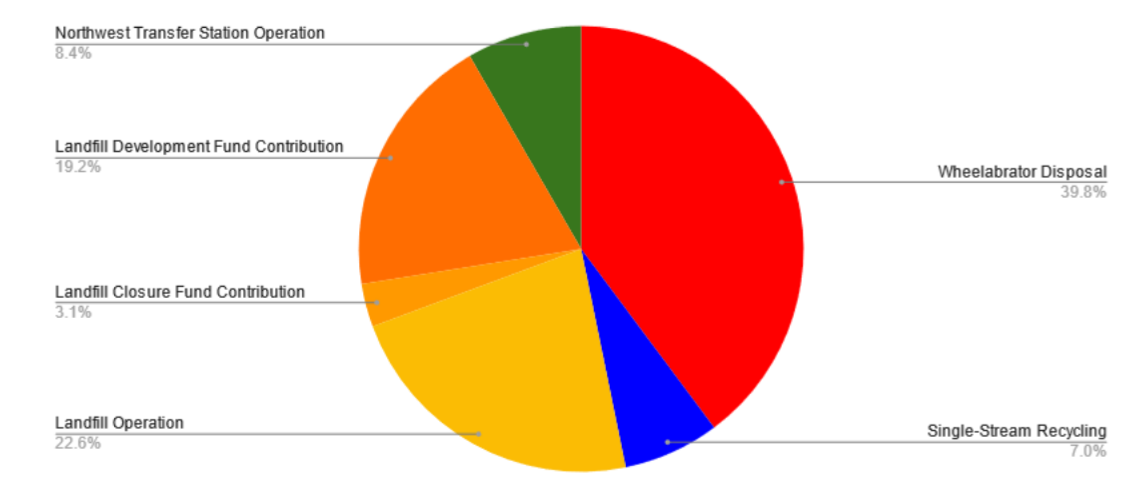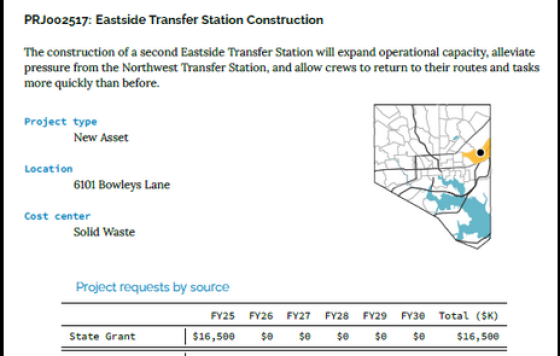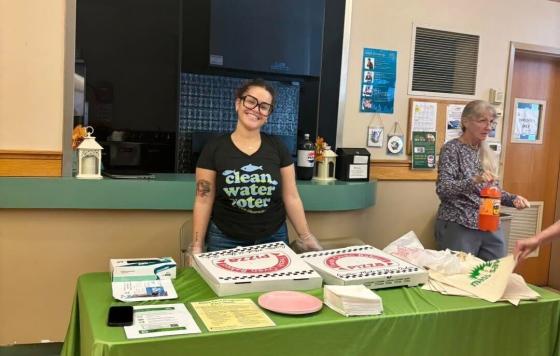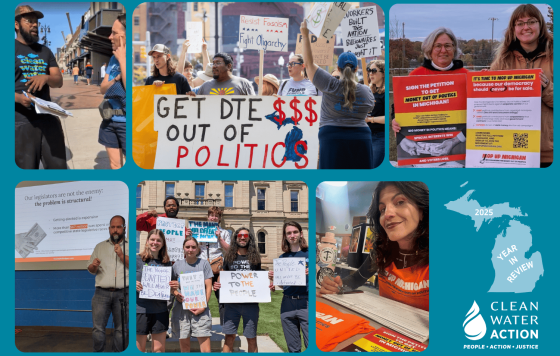
Tonight is Taxpayers' Night, the annual City Council hearing on Baltimore City's budget. Read our testimony on Zero Waste, trash incineration and sewage backups below! And stay tuned for the Department of Public Works budget hearing on June 3.
Download as PDF here:

Thursday, May 16, 2024
Dear Baltimore City Council,
As you consider Baltimore City’s FY25 budget and six-year capital spending plan, please take action to ensure it adequately invests in the programs and infrastructure Baltimore needs to (1) transition away from trash incineration and to Zero Waste; and (2) protect residents from the unsafe impacts of building sewage backups.
Zero Waste: Capital Budget
In November 2020, Baltimore City, as part of settling the lawsuit brought against the City over the Baltimore Clean Air Act, signed a 10-year contract to continue sending City-hauled waste to the BRESCO trash incinerator until December 31, 2031. At the time, then-Council-President Scott said, “Under my administration, we’re going to work to not burn as much at the incinerator as possible... And I will work my butt off to make sure that this is the last time we ever give them a new contract.” Baltimore must aggressively invest in infrastructure and program development to reduce the amount of waste produced in the city, divert it to reuse, recycling, and compost; and send decreasing amounts of waste to be burned at the incinerator each year, to ensure that the City faces no pressure to sign another contract with the incinerator in 2031.
The Less Waste Better Baltimore Master Plan (2020) and the 10-Year Solid Waste Management Plan (2024) outline programmatic and infrastructure investments that can reduce and divert Baltimore’s waste. The Less Waste Better Baltimore plan projected that Baltimore could achieve its Maximum Diversion Potential (increasing the overall diversion rate for all waste in Baltimore from 45% to about 83%) over a timespan of 20 years of investment, noting that “a 20-year performance timeframe means that it is expected that 50% of the MDP will be achieved in 10 years, 90% of the MDP will be achieved in 15 years, and 100% of the MDP will be achieved within 20 years.” It also noted that achieving this maximum diversion potential sooner was within the City’s grasp: “The City could aim to decrease any performance timeframe by phasing in options faster than assumed herein and/or by increasing funding to education, outreach, and other efforts to stimulate participation.” (page 22)
However, instead of increasing funding to accelerate waste diversion or even meeting the timelines laid out in existing plans, this budget defunds and delays key aspects of needed Zero Waste infrastructure compared to these plans and to last year’s capital budget plan. There is no capital spending allocated in FY25 for Zero Waste infrastructure.
Capital budget allocations for FY25 for Solid Waste in CB24-0521
Composting facilities
The 10-Year Solid Waste Management Plan (SWMP) approved in February proposes a phased-in, decentralized approach to building 20,000 ton/year compost facilities throughout the city sequentially to meet growing demand for compost processing capacity throughout the planning period. The plan proposes beginning design and permitting of the first composting facility in 2025 to have it operational by 2028. (pages 186-189)
In the FY24 Six Year Capital Program, DPW requested $2 million of GO Bond funding per year starting in 2026 to construct these compost facilities.

City of Baltimore - Six Year Capital Program
FY24 Agency Request for: DPW: Solid Waste
In September 2023, Baltimore City received an EPA grant of $4 million to construct the first compost facility at a capacity to process just 12,000 tons per year, just over half of the tonnage called for per facility in the SWMP. The Planning Commission incorporated that into the FY24 capital budget, and reduced and delayed GO Bond investment into constructing further compost facilities until 2028.

City of Baltimore - Six Year Capital Program
FY24 Planning Recommendation for: DPW: Solid Waste
The proposed FY25 Six-Year Capital Program, however, eliminates this FY28 and FY29 funding. It includes no additional funding for constructing additional compost facilities through the duration of the planning period, through FY30. DPW did not request any capital funding for composting through the FY25-FY30 planning period, nor was any added by the Planning Commission.
The 2023 EPA grant to construct the City’s first compost facility may even be at risk. This facility is proposed to be located at the future Eastside Transfer Station on Bowley’s Lane, and the general construction of the transfer station is incorporated into the proposed FY25 Six Year Capital Program. In its Agency Requests for FY25, DPW anticipated receiving $16.5 million in support from the state for this facility.
Baltimore City 6-Year Capital Improvement Program
FY2025-2030, Requests by Agency
However, this project was not funded in the state budget. As a result, the Planning Commission recommended a GO Bond increase for a Special Projects Set-Aside allocating $12.5 million in GO Bonds in FY26 to the Eastside Transfer Station. The Staff Report noted (page 4):
“The Department of Public Works earmarked $16.5 million in State funding for the Eastside Transfer Station. This funding was not part of the Governor’s initial budget, leaving the transfer station still partially funded. DPW has received a $4 million EPA grant for composting at the same site, which will rely on infrastructure constructed as part of the transfer station project. DPW has three years to spend the EPA grant, putting these funds at risk if the transfer station is not funded in FY26. It will be critical to fully fund the transfer station in FY26 so work can commence.
Baltimore must aggressively invest in increasing its composting capacity. The current proposed FY25 Six Year Capital Program reduces future spending for composting facilities compared to last year, which is unacceptable. We also cannot risk endangering losing our current federal funding for our first compost facility. We should move more quickly than is called for in the Less Waste Better Baltimore plan and the SWMP; we cannot afford to move more slowly.
Recycling facilities:
Similarly, the proposed FY25 Six Year Capital Program reduces future investments in recycling capacity and is not in alignment with City plans.
The SWMP proposes constructing small-scale Materials Recovery Facilities (recycling plants) to reduce transportation costs and reliance on out-of-city vendors. It projects that design, permitting, and construction would take three years, and a new MRF could become operational as soon as 2029. (pages 184-186)
In the FY24 Six Year Capital Program, DPW requested $5 million of GO Bond funding per year starting in 2028 to construct these Materials Recovery Facilities.
City of Baltimore - FY24 Six Year Capital Program
Agency Request for: DPW: Solid Waste
The Planning Commission eliminated future funding for Materials Recovery Facilities through FY29 in the FY24 Six Year Capital Program.
City of Baltimore - FY24 Six Year Capital Program.
Planning Recommendation for: DPW: Solid Waste
In the FY25 Six Year Capital Program, DPW did not request any funding for Materials Recovery Facilities at all through FY30. None was added by the Planning Commission.
Construction and demolition recycling facility:
In the FY24 Six Year Capital Program, DPW requested funding beginning in 2025 to develop a modern Construction and Demolition Recycling facility.
City of Baltimore - FY24 Six Year Capital Program
Agency Request for: DPW: Solid Waste
The Planning Commission delayed and reduced funding to 2027 in the FY24 Six Year Capital Program.
City of Baltimore - Six Year Capital Program
FY24 Board of Estimates Recommendation for: DPW: Solid Waste
The FY2025-FY30 Six Year Capital Program maintains this later start date of FY27, with reduced funding, then increases funding in FY28 and FY29 compared to last year’s six-year plan.
Baltimore City 6-Year Capital Improvement Program
FY2025-FY2030 Planning Commission Recommendations
The FY25-FY30 Six Year Capital Program brings Baltimore City within just one year of the end of the City’s current contract with BRESCO. To meet the City’s values and stated commitments to transitioning away from trash incineration, we must invest in developing better infrastructure to manage our waste. This infrastructure will also have many cobenefits, reducing air pollution and creating jobs. It is unacceptable to have no plan to fund additional composting and single-stream recycling infrastructure through 2030.
Zero Waste: Operating Budget
The proposed FY25 Operating Budget increases funds for trash incineration and spends disproportionately more on incineration and landfilling than on recycling. Its performance measures demonstrate that Baltimore must change course to meet its Zero Waste commitments.
In Service 663: Waste Removal and Recycling (Agency Detail II, pages 287-289), the budget by activity shows significantly more funding allocated to landfilling and incineration than to recycling, consistently over time.
- Increasing funding to trash incineration: The funding allocated to Wheelabrator Disposal (the BRESCO trash incinerator) increases by 37% between FY24 and FY25, while funding for single-stream recycling only increases by 4%, on par with inflation.
FY25 Board of Estimates Recommendations
Agency Detail - Volume II
- Disproportionate investment in incineration and landfilling each year: The FY25 budget for this service item invests significantly more into incineration and landfilling than into recycling.
As might be expected with such disproportionately low recycling investment, the budget’s Performance Measures show decreased performance on waste diversion over time.
- The Performance Measures for Section 663: Waste Removal and Recycling show decreasing tonnages of recycling collected between FY20 and FY22. However, rather than maintaining expectations and working to meet the target for the past two fiscal years (30,000 tons), the FY25 budget decreases the target by 23% to 23,000 tons. In the meantime, the FY25 budget increases the target for tonnage of mixed refuse collected to 152,000 tons.
FY25 Board of Estimates Recommendations
Agency Detail - Volume II
- The Performance Measures for Service 664: Waste Re-Use and Disposal show that the actual percentage of waste in tonnage collected by DPW that goes to recycling is not increasing (ignoring FY21, during the height of pandemic service disruptions) and is well below the target.
FY25 Board of Estimates Recommendations
Agency Detail - Volume II
Meeting the City’s stated Zero Waste goals, accomplishing the diversion rates planned in Less Waste Better Baltimore and the SWMP, and transitioning away from trash incineration by or before 2031 require aggressive action from City leadership. We must invest capital funding in Zero Waste infrastructure like composting and recycling, and we must spend our operating dollars in line with our values rather than spending the most on incineration and landfilling. The proposed FY25 budget is not a step in the right direction. On too many of these necessary building blocks, it is a step in the wrong direction, continuing and worsening the spending trends that lead to Baltimore burning our trash at the incinerator.
Sewage backups
For years, residents, community associations, and environmental organizations across Baltimore have been demanding that DPW provide meaningful assistance to household facing sewage flooding backwards from the City’s sewer system into homes. In 2018, DPW launched the Expedited Reimbursement Program (ERP), required by the Modified Consent Decree; in 2019 and 2020, following City Council investigative hearings, DPW made a number of policy improvements to the program; and in 2021, DPW launched the Sewage Onsite Support (SOS) program. Throughout these years, however, DPW has maintained the most onerous restriction on these programs that prohibits most impacted residents from receiving assistance: only making sewer backups caused by wet weather events eligible for help.
The majority of sewer backups into homes occur during dry weather, but households facing such a backup can currently receive no help from the City, even when the cause of the backup originated in the City’s infrastructure. Our report with Blue Water Baltimore, Expanding Baltimore City’s Sewage Backups Assistance Programs, estimates that offering such assistance to each household facing a backup originating in City infrastructure would cost approximately $5.9 million, if every single qualifying household used the City’s assistance. (Without offering such assistance, these costs don’t go away - they are displaced onto your constituents facing sewage backups from city infrastructure through no fault of their own.)
Baltimore must budget and actually spend funds to help households with sewage backups.
The 2017 Modified Consent Decree requires DPW to budget $2 million each year for the Expedited Reimbursement Program. In the FY23 budget, $2.5 million was allocated in Service 670: Administration - Water and Wastewater for the SOS program (FY23 Agency Detail Volume II, page 267). DPW has proposed replacing the Expedited Reimbursement Program with the Sewage Onsite Support program. According to the most recent available data about the ERP, no funding has been spent on it since FY21. The Council should ask for updated information about the ERP and similar transparency about funds spent on the SOS.
MCD Quarterly Report #26, page 5
DPW must stop disputing EPA and MDE’s order to expand sewage backup assistance programs and help all households facing sewer backups from city infrastructure.
In May 2023, EPA and MDE ordered DPW to expand the Sewage Onsite Support program to cover all sewer backups caused by conditions in the City’s sewer system. However, DPW refused to comply with that order. For an entire year, DPW has been putting its time and effort into disputing EPA’s order and ignoring residents’ longtime demands, refusing to provide vital financial and public health assistance to people who face catastrophes as a result of the City’s infrastructure. The Council should ensure that the budget reflects funding necessary to follow EPA and MDE’s order, and should hold DPW accountable to using that money to assist your constituents facing sewer backups.
The relevant performance measure in the budget obscures the reality of sewage backups in Baltimore City.
In Service 675: Engineering and Construction Mgt - WWW, the number of Water in Cellar incidents during the reporting period per 100 customer accounts is given as a performance measure. The figure is a constant 0. This is a new performance measure this year; it was not given in the FY24 budget.
FY25 Board of Estimates Recommendations
Agency Detail - Volume II
It is hard to imagine a metric that would do more to obscure and confuse the truth about the prevalence of sewer backups in the city. It is irrational to engineer a measure so that its results would not reflect any change without an unimaginably catastrophic increase in sewer backups in the city one year bringing the number close to 1 in 100 accounts. Even presenting this figure per 1,000 customer accounts, like the number of water quality complaints given above it, would show meaningful figures and change over time.
DPW identifies the list of building backups that occurred in each quarter in its Modified Consent Decree Quarterly Reports; the total figure per year would be easy to provide as a performance measure. In FY23, the most recent year for which complete data is available, these reports list approximately 4,749 total sewer backups, and approximately 2,101 sewer backups whose cause DPW identifies as “Mainline” or “Mainline and Lateral” (meaning that the cause was in whole or in part located in the City’s infrastructure, rather than the resident’s property - those the EPA has ordered DPW to provide assistance for). Either of these figures combined with the number of sewage backups that actually received assistance through each of DPW’s two assistance programs would present a meaningful performance measure, unlike the performance measure presented here.
—
Thank you for your careful consideration of the FY25 budget; please work to ensure that Baltimore City adequately invests in the programs and infrastructure Baltimore needs to (1) transition away from trash incineration and to Zero Waste; and (2) protect residents from the unsafe impacts of building sewage backups.
Sincerely,
Jennifer Kunze
Maryland Organizing Director
Clean Water Action



